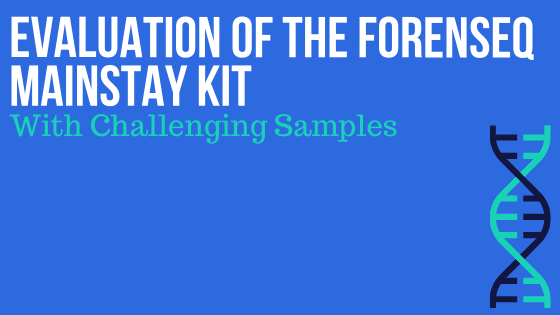My previous work involved the development of a kit using alternative markers, specifically Insertion Deletions (INDELs). The goal was to design a kit using ancestry informative markers (AIMs) to help differentiate samples based on ancestral genetic information. In addition, this INDEL kit was designed with amplicons less than 200 bp to maximize recovery with challenging samples. My focus on improving the recovery of DNA from challenging samples led me to explore next-generation sequencing (NGS).
Previously, NGS has been successful in recovering DNA from historical remains and bones. The power of NGS comes from its ability to analyze more amplicons simultaneously than capillary electrophoresis (CE). Additionally, these amplicons are much smaller on average than CE because there is no need to separate amplicons by size with NGS. Another key benefit is the “S” in NGS, which is the sequencing aspect. Sequencing provides the analyst base-by-base resolution of the DNA, not just a comparative assessment of amplicon size. It’s like shifting from analog to digital data.
Written by: Lucio Avellaneda, Sam Houston State University
My current research involves the evaluation of the ForenSeq MainstAY Kit, the new library preparation kit from Verogen. I was excited to collaborate with Verogen on beta testing to provide input for the final product. Our lab has previously worked with another Verogen chemistry, the ForenSeq DNA Signature Prep Kit. The ForenSeq DNA Signature Prep Kit contains over 200 markers, including autosomal STRs, Y-STRs, X-STRs, identity SNPs, ancestry SNPs, and phenotypic SNPs. However, for standard casework, a lab only needs CODIS eligible STR data. ForenSeq MainstAY focuses on typical forensic casework, specifically sexual assault evidence, and includes autosomal STRs (25) and Y-STRs (27). This decrease in marker complexity will increase sensitivity in comparison to the ForenSeq DNA Signature Prep Kit.
To evaluate ForenSeq MainstAY, we assessed repeatability between examiners, sensitivity, challenging sample recovery, and comparison to CE STR kits. Sensitivity was assessed in quadruplicate using DNA concentrations from 1 ng to 8 pg. Challenging samples included bone, blood, saliva, and hair extracts. Data for challenging samples were collected using both CE chemistry and the ForenSeq MainstAY chemistry.
Our study showed the ForenSeq MainstAY kit recovered all loci down to 31pg with both pristine and low quantity samples. Additionally, at 8 pg, 40- 50% of loci were recovered. ForenSeq MainstAY results from the challenging samples showed small to considerable improvements in recovery compared to CE data. For example, a recovery of 4% in CE increased to 40% with the ForenSeq MainstAY chemistry. The ForenSeq MainstAY Kit also has a higher marker count than one CE STR kit, which increases its data per sample.
We will be continuing this project by focusing on two areas. First, we will stress test the system with numerous high-level samples of multiple contributors and some mixtures of extreme trace donors of only 1-2%. This will assess the kit’s ability to recover all contributors in a mixture and determine the benefits of detected isoalleles regarding mixture deconvolution. Second, Verogen will be releasing an enhanced PCR buffer for their STR kits later this year. We will be evaluating this buffer’s ability to improve STR recovery from previously run challenging samples.
Currently, many labs across the United States do not have an NGS instrument in house. If a lab wishes to incorporate NGS technology into their toolkit, they will need to make an initial investment in training and instrumentation. However, I believe that NGS, and specifically ForenSeq MainstAY, may indeed become a “mainstay” for standard casework. By switching to one chemistry that simultaneously targets both autosomal and Y-STRs, the laboratory will save time and money and eliminate choosing between different STR kits for a sample – now, you can run them all at once. Additionally, I am continuing my PhD focusing on NGS because I believe there are unrealized benefits of NGS in terms of sensitivity, recovery of degraded DNA, and mixture deconvolution.
WOULD YOU LIKE TO SEE MORE ARTICLES LIKE THIS? SUBSCRIBE TO THE ISHI BLOG BELOW!
SUBSCRIBE NOW!


